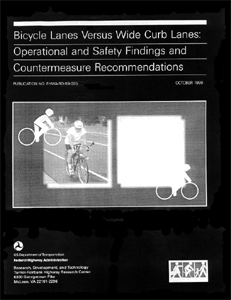Bicycle Lanes Versus Wide Curb Lanes
Operational and Safety Findings and Countermeasure Recommendations
PDF Version (2.82 MB)
PDF files can be viewed with the Acrobat® Reader®
FOREWORD
There is a variety of on- and off-road bicycle facilities - each with its advantages and disadvantages. A thorough evaluation of the various kinds of facilities implemented in pro-bicycling communities has been needed by the traffic engineering profession. One of the studies under the FHWA's Pedestrian and Bicycle Safety Research Program investigated the long-standing issue of whether bicycle lanes or wide curb lanes are preferable. Overall, the study indicated that both bicycle lanes and wide curb lanes can and should be used to improve riding conditions for bicyclists.
This document presents a summary of the research study, providing operational and safety findings and countermeasure recommendations regarding bicycle lanes and wide curb lanes. The information contained in this report should be of interest to State and local transportation engineers, planners, researchers, and bicycle coordinators.

Michael F. Trentacoste
Director, Office of Safety
Research and Development

TECHNICAL REPORT DOCUMENTATIION
| 1. Report No. FHWA-RD-99-035 |
2. Government Accession No. |
3. Recipient's Catalog No. |
| 4. Title and Subtitle
Bicycle Lanes Versus Wide Curb Lanes: Operational and Safety Findings and Countermeasure Recommendations
|
5. Report Date |
| 6. Performing Organization Code |
| 7. Author(s)
William W. Hunter, J. Richard Stewart, Jane C. Stutts, Herman H. Huang, and Wayne E. Pein
|
8. Performing Organization Report No. |
| 9. Performing Organization Name and Address
University of North Carolina
Highway Safety Research Center
730 Airport Road, CB #3430
Chapel Hill, NC 27599
|
10. Work Unit No.(TRAIS) |
| 11. Contract or Grant No.
DTFH61-92-C-00138
|
| 12. Sponsoring Agency Name and Address
Office of Safety and Traffic Operations Research & Development
Federal Highway Administration
6300 Georgetown Pike
McLean, Virginia 22101-2296
|
13. Type of Report and Period Covered
Final Report
March 1995 - May 1998
|
| 14. Sponsoring Agency Code |
| 15. Supplementary Notes
Contracting Officer's Technical Representative (COTR): Carol Tan Esse, HSR-20
|
| 16. Abstract
This report presents operational and safety findings and countermeasure
recommendations from a comparative analysis of bicycle lanes versus
wide curb lanes. The primary analysis was based on videotape of almost
4,600 bicyclists in Santa Barbara, CA, Gainesville, FL, and Austin,
TX. The videotapes were coded to evaluate operational characteristics
and conflicts with motorists, other bicyclists, or pedestrians.
Significant differences in operational behavior and conflicts were
found between bike lanes and wide curb lanes but varied depending on
the behavior being analyzed. Wrong-way riding and sidewalk riding were
much more prevalent at WCL sites compared with BL sites. Significantly
more motor vehicles passing bicycles on the left encroached into the
adjacent traffic lane from WCL situations compared with BL situations.
Proportionally more bicyclists obeyed stop signs at BL sites; however,
when a stop sign was disobeyed, the proportion of bicyclists with both
"somewhat unsafe" and "definitely unsafe" movements
was higher at BL sites. The vast majority of observed bicycle-motor
vehicle conflicts were minor, and there were no differences in the conflict
severity by type of bicycle facility. Bicyclists in WCLs experienced
more bike/pedestrian conflicts while bicyclists in BLs experienced more
bike/bike conflicts. An initial model fitted to the intersection conflicts
showed no differences in the conflict rate by type of bicycle facility,
but showed higher conflict rates for left turn movements.
The overall conclusion is that both BL and WCL facilities can
and should be used to improve riding conditions for bicyclists. The
identified differences in operations and conflicts appeared to be related
to the specific destination patterns of bicyclists riding through the
intersection areas studied and not to the characteristics of the bicycle
facilities.
In addition to this implementation, there is a final report (FHWA-RD-99-034)
containing a complete discussion of the research method, data collection
procedures, and data analysis, as well as a guidebook (FHWA-RD-99-036)
about innovative bicycle accommodations.
|
| 17. Key Words
Bicycle lane, wide curb lane, bicycle operations, bicycle maneuvers, conflicts
|
18. Distribution Statement
No restrictions. This document is available to the public through the National Technical Information Service, Springfield, VA 22161.
|
| 19. Security Classification (of this report)
None
|
20. Security Classification (of this page)
None
|
21. No. of Pages
31
|
22. Price |
| Form DOT F 1700.7 (8-72) |
Reproduction of completed page authorized |
|
